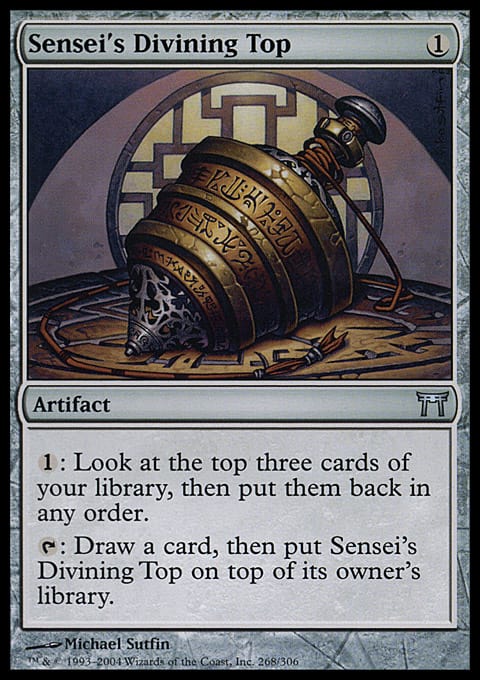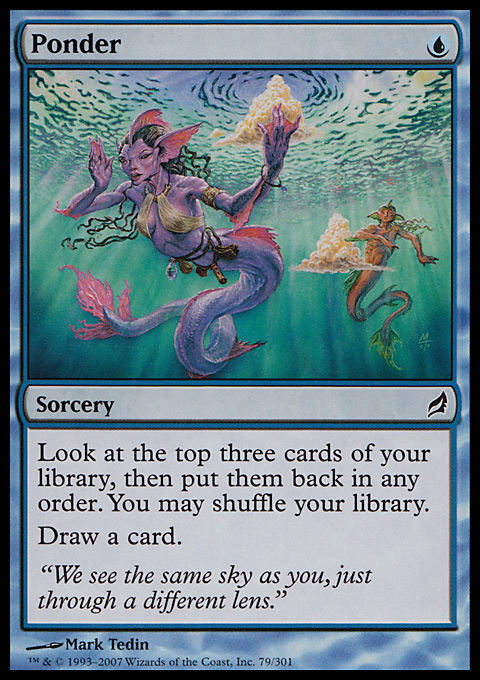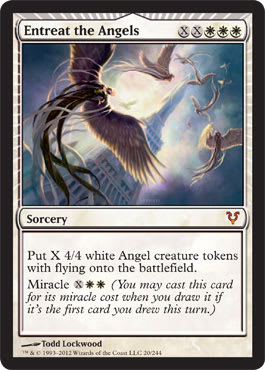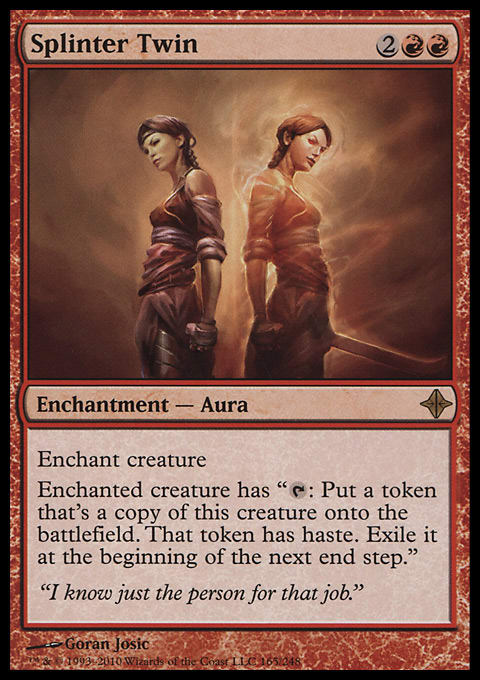Legacy has entered an interesting phase in its development as a format. With no major tournaments in the immediate future, and only a few large data points to use for making observations about the position of the format, many players are left in kind of a holding pattern waiting for a new shake-up to stir the stew. Last week, we talked about ![]()
![]() Depths as an under-appreciated combo deck with resilience provided by Black’s proactive discard, rather than Blue’s reactive countermagic and cantrips. This week, it’s time to discuss the evolution of control, which has slowly but surely risen to be a major macro-archetype even in the absence of Sensei's Divining Top. Three major breeds of control currently coexist in Legacy, and each of them brings something unique to the table. (Of course, there are countless minor control decks with their own unique twists and angles, but that is true of every macro-archetype in Legacy, where the sheer depth of the card pool almost mandates this type of diversity.)
Depths as an under-appreciated combo deck with resilience provided by Black’s proactive discard, rather than Blue’s reactive countermagic and cantrips. This week, it’s time to discuss the evolution of control, which has slowly but surely risen to be a major macro-archetype even in the absence of Sensei's Divining Top. Three major breeds of control currently coexist in Legacy, and each of them brings something unique to the table. (Of course, there are countless minor control decks with their own unique twists and angles, but that is true of every macro-archetype in Legacy, where the sheer depth of the card pool almost mandates this type of diversity.)
Today we’ll be talking about Four-Color Leovold, ![]()
![]() Semi-Miracles, and Jeskai Stoneblade (with and without Splinter Twin!) As for my personal hobbyhorses, Esper Stoneblade and Four-Color Delver (which is the closest Delver ever gets to a legitimate control deck), too much discussion would be re-treading old ground. When the triple-format team Grand Prix come around, it may be appropriate to discuss updated versions of those decks in depth again, but until then, the archived lists and strategic content from the past several months are more than enough to give any player a head start on mastering the lists.
Semi-Miracles, and Jeskai Stoneblade (with and without Splinter Twin!) As for my personal hobbyhorses, Esper Stoneblade and Four-Color Delver (which is the closest Delver ever gets to a legitimate control deck), too much discussion would be re-treading old ground. When the triple-format team Grand Prix come around, it may be appropriate to discuss updated versions of those decks in depth again, but until then, the archived lists and strategic content from the past several months are more than enough to give any player a head start on mastering the lists.
As for Four-Color Leovold, it has overtaken Grixis Delver as the most played deck in all of Legacy. Occasionally called Czech Pile, the deck rose to prominence as one of the few archetypes that could beat Miracles at its own game; the combination of disruption, countermagic, card advantage and troublesome permanents pushed the matchup with Legacy’s ‘best deck’ above 50%. That said, the deck has the tools at its disposal to win almost any matchup, and as such it makes sense that it would rise as a predator in the new Legacy metagame.
Here’s a recent list, keeping in mind that the deck has few sacred cows, and players should feel comfortable tweaking the deck to suit their own preferences:
Four-Color Leovold ? Legacy | Ben Friedman
- Creatures (13)
- 1 Gurmag Angler
- 2 Leovold, Emissary of Trest
- 3 Baleful Strix
- 3 Snapcaster Mage
- 4 Deathrite Shaman
- Planeswalkers (3)
- 1 Liliana of the Veil
- 2 Jace, the Mind Sculptor
- Instants (15)
- 1 Abrupt Decay
- 1 Diabolic Edict
- 1 Lightning Bolt
- 2 Fatal Push
- 2 Kolaghan's Command
- 4 Brainstorm
- 4 Force of Will
- Sorceries (9)
- 1 Toxic Deluge
- 2 Hymn to Tourach
- 2 Thoughtseize
- 4 Ponder
- Lands (20)
- 1 Island
- 1 Swamp
- 1 Badlands
- 1 Bayou
- 1 Bloodstained Mire
- 1 Tropical Island
- 1 Verdant Catacombs
- 2 Misty Rainforest
- 2 Volcanic Island
- 2 Wasteland
- 3 Underground Sea
- 4 Polluted Delta
- Sideboard (15)
- 1 Diabolic Edict
- 2 Hymn to Tourach
- 1 Ancient Grudge
- 2 Blue Elemental Blast
- 2 Flusterstorm
- 1 Marsh Casualties
- 1 Nihil Spellbomb
- 3 Red Elemental Blast
- 2 Surgical Extraction
What a . . . pile! A beautiful sculpture of some of Legacy’s greatest hits, stitched together with Ponder and Brainstorm, with a sideboard to shore up weaknesses against all the prevalent linears of the format. Of course, there will be awkward moments of “Island, Volcanic Island, Deathrite Shaman, Hymn to Tourach” openers, but the sheer diversity and quality of its answers makes up for the occasional inconsistency. Part of the beauty of the deck is how customizable it is to tailor for any metagame. Lands getting you down? A third Diabolic Edict, a third or fourth Surgical Extraction, and suddenly the matchup becomes quite positive post-sideboard. Storm and Sneak and Show blasting off one too many times for you? Those Blue Elemental Blasts can easily become Spell Pierces, Thoughtseizes, or more Flusterstorms. The possibilities are virtually limitless, and the only thing that really puts a crimp in this deck’s plan is the dreaded turn one Blood Moon. (Then again, what Deathrite Shaman-Brainstorm deck isn’t crippled by a Blood Moon? It’s kind of the cost of doing business in Legacy these days.)
With decent-to-strong matchups against Death and Taxes, new Miracles, and Delver, a serviceable combo matchup, and fixable weaknesses to Elves and Lands, this is the midrange/control deck for those who want to play the most actual Magic at their next Legacy event. It’ll be somewhere around 10% of the metagame at any tournament for the foreseeable future, so it will pay dividends to learn the ins and outs of the archetype. Get cracking!
Of course, Deathrite Shaman isn’t the only way to play fair Brainstorm decks in Legacy. Believe it or not, there are a few alternatives, chief among them the Michael Jordan-esque new Miracles deck. (Of course, we’re talking about MJ on his third NBA career, when he was pushing 40 and still competing with players half his age). Like MJ, Miracles has been hobbled by the loss of Sensei's Divining Top, but somehow in its new form as a clean ![]()
![]() control deck, it still manages to stay competitive with the best and brightest of Legacy. Here’s the most recent Legacy Challenge 6-0, in all its topless glory:
control deck, it still manages to stay competitive with the best and brightest of Legacy. Here’s the most recent Legacy Challenge 6-0, in all its topless glory:
Miracles ? Legacy | Ben Friedman
- Creatures (3)
- 3 Snapcaster Mage
- Planeswalkers (3)
- 3 Jace, the Mind Sculptor
- Instants (22)
- 1 Flusterstorm
- 2 Unexpectedly Absent
- 3 Counterspell
- 4 Brainstorm
- 4 Force of Will
- 4 Predict
- 4 Swords to Plowshares
- Sorceries (12)
- 1 Entreat the Angels
- 3 Portent
- 4 Ponder
- 4 Terminus
- Lands (20)
- 2 Plains
- 6 Island
- 2 Arid Mesa
- 3 Scalding Tarn
- 3 Tundra
- 4 Flooded Strand
- Sideboard (15)
- 3 Flusterstorm
- 2 Ethersworn Canonist
- 3 Leyline of Sanctity
- 4 Monastery Mentor
- 3 Surgical Extraction
So. Many. Cantrips. A full fifteen of the cards in this deck serve no purpose other than to replace themselves, with Brainstorm and Ponder joined by Portent and Predict. Aside from those, the deck is all removal, counterspells, Snapcaster Mages, Jaces, and one Entreat the Angels. Clean, bright, and ready to rock and roll despite the lack of a continuous deck manipulation engine, this deck beats up pretty well on Grixis Delver, and has a reasonable combo matchup post-sideboard. Sure, it lost the positive Lands matchup Counterbalance once provided, but with a few Surgical Extractions in the sideboard the matchup is still plenty serviceable. Oddly enough, the matchup against Czech Pile isn’t even that bad overall, but the Red Elemental Blasts in the sideboard really put the screws to Miracles. Fortunately the sideboard juke of Monastery Mentor can still win loads of games, and the four-color deck has to respect your potential switcheroo way more than you have to respect its incremental improvements.
Leyline of Sanctity is a bit of an odd duck here, as a three-of that helps some of the more obscure matchups in the format. Sure, it’s great against Thoughtseize and Hymn to Tourach, but a lot of those decks will have Liliana of the Veil (which both discards without targeting, and allows opponents to pitch their now-dead discard spells). Additionally, it’s a pretty bad draw in the midgame, and only really helps with Storm if they don’t go the Empty the Warrens route. I’d probably lose that one for a few Disenchants or another counterspell or Ethersworn Canonist, but maybe Burn is prevalent enough in the MTGO metagame to warrant the inclusion.
One other item of note for this deck is the surprisingly weak matchup to Elves, of all things. You’d think with a pile of Terminus the matchup would be a breeze, but Elvish Visionary and Wirewood Symbiote make a fairly insane draw engine, and the lack of the Counterbalance hard lock means that Elves gets tons of time to rebuild even through all the removal in the world. It’s not a bad matchup by any means, but it’s just not quite as clean-cut as it used to be, and that’s a small strike against new Miracles.
That being said, Elves isn’t as popular as it should be, given the difficulty of the deck and the expense of Gaea's Cradles, and new Miracles’ matchup against Death and Taxes is as good as it was with Counterbalance and Top. The mana base is hard to disrupt, the cantrips require less of a mana investment (and can’t be stopped with a Phyrexian Revoker!), and Unexpectedly Absent provides a maindeck answer to the problematic equipment that plagued past Miracles decks.
Plus, as a bonus feature, this is a fair Brainstorm deck that doesn’t bite it to a Blood Moon. What a blessing! Chalice of the Void, on the other hand, is quite a beating, so keep those Unexpectedly Absents close.
Now, pure control is all well and good, but let’s say you want to bring back the ultimate hybrid archetype. In Magic’s history, no archetype has been more dominant than Combo-Control. Think Thopter Depths. Four-Color Saheeli. Legacy Lands (sort of). More busted Vintage decks than you can shake a stick at. And, of course, basically every Splinter Twin mashup. That’s where we’ll start looking here, with none other than the Legacy adaptation of the one, the only, Twin-Blade. WuYuHsien’s recent list is a rough starting point, but the power of a control deck with a combo finish is not to be ignored in Legacy.
Twin-Blade ? Legacy | WuYuHsein
- Creatures (14)
- 1 True-Name Nemesis
- 2 Deceiver Exarch
- 2 Snapcaster Mage
- 2 Vendilion Clique
- 3 Pestermite
- 4 Stoneforge Mystic
- Planeswalkers (1)
- 1 Jace, the Mind Sculptor
- Instants (15)
- 1 Counterspell
- 2 Spell Pierce
- 4 Brainstorm
- 4 Force of Will
- 4 Swords to Plowshares
- Sorceries (4)
- 4 Ponder
- Enchantments (3)
- 3 Splinter Twin
- Artifacts (2)
- 1 Batterskull
- 1 Umezawa's Jitte
- Lands (21)
- 1 Mountain
- 1 Plains
- 4 Island
- 1 Arid Mesa
- 1 Plateau
- 2 Tundra
- 3 Volcanic Island
- 4 Flooded Strand
- 4 Scalding Tarn
- Sideboard (15)
- 2 Blood Moon
- 2 Containment Priest
- 1 Detention Sphere
- 1 Ethersworn Canonist
- 1 Grafdigger's Cage
- 1 Grim Lavamancer
- 1 Pithing Needle
- 2 Pyroblast
- 2 Pyroclasm
- 2 Wear // Tear
Is it tuned? No. Is it powerful? You betcha. Brainstorm is the ultimate in card filtration here, allowing you to smoothly tuck away combo pieces when you need to be a control deck, while digging up the two-card instant win on command when it’s time to go for the kill. Like any good Twin deck, this one thrives on the false tempo gained from an opponent’s desire to play around the deadly combo, and exploits their caution to gain a massive edge. The combo also gives this particular deck a stronger matchup against Lands or Elves, allowing a quick finish after a flurry of disruption. Sure, there are a metric ton of 3-drops in this particular list, but it is acceptable to shave one or two of them to fit in some Lightning Bolts or Flusterstorms.
Let me be clear. This deck is a bit more schizophrenic than other Legacy decks. It’s playing a mishmash of the creators’ favorite cards, with some one-ofs that might not be the optimal choices. It can draw opening hands that make you retch, hands with two Splinter Twins and an Umezawa's Jitte with no way of turning them into new cards. In exchange, there will be plenty of other games where your opponents will be at a loss for how to apply adequate pressure while playing around the combo, and the extra time gained by their hesitation is the time you need for Stoneforge Mystic or True-Name Nemesis to take the upper hand. The only other deck in Legacy with this kind of mental advantage is Infect, which has faded away in the face of improved removal suites (read: Fatal Push) from the midrange strategies. Do not underestimate this advantage, as it wins games. With a slightly better sideboard, it might even be possible to remove the entire combo from the deck in post-board games while retaining a psychological advantage from the opponent’s uncertainty about a looming instant death. Playing control when the opponent tries to play around a non-existent combo is a true delight in Magic, a perfect mental coup in the style of “The Art of War”.
In fact, if it weren’t for the annoyingly high mana cost of the two combo pieces, and their associated vulnerability to Delver’s Dazes, Twin-Blade would be a clear top deck in Legacy. As it currently stands, Daze is a hard card for Twin-Blade to beat, but the deck is still great relative to the amount of play it currently sees. The sheer rogue factor and unpredictability of the deck (with the attendant difficulty of playing against it) justifies its existence right now, and it might just be a deck to pick up for a Sixty-Card Shootout in the near future. Keep your eyes peeled!




























